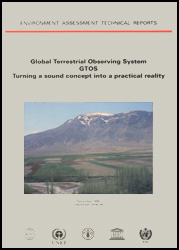

ENVIRONMENT ASSESSMENT TECHNICAL REPORTS
December 1995
UNEP/EAP. TR/95-08
ISBN: 92-807-1556-9
For bibliographic and reference purposes this publication should be referred to as:
ICSU/UNEP/FAO/UNESCO/WMO (1996). Global Terrestrial Observing System (GTOS):
Turning a sound concept into a practical reality - UNEP/EAP.TR.95-08
Division of Environment Information and Assessment
United Nations Environment Programme
P.O. Box 30552, Nairobi, Kenya
This report has been produced without editorial revision by the co-sponsors of the GTOS - ICSU/UNEP/FAO/UNESCO/WMO. Its distribution in its present form does not imply endorsement by the co-sponsors of the ideas expressed.
Part I: Towards a basic proposal
Our dependence on terrestrial ecosystems
Reducing uncertainties about the sustainability of terrestrial ecosystems
Human capacity development
Assisting with international obligations
Complementing and improving the returns to major investmentsGuiding principles
Conceptual framework
How will it be organised?
Lead agency
Institutional framework
Operational procedures
Site and variable selection
Data exchange and harmonizationWhat will GTOS cost?
Benefits at the global level
Benefits at the national/regional level
Part II: The proposal in detail
International agencies
International conventions
International global science programmes
Earth observation systemsProducts and services
The observing systemGuiding principles
The sampling strategy
The sampling hierarchy explained
Integration of the hierarchical data and data from other sources
Principles for site selection
Use of the 5-tier hierarchy for examining global issues
Potential GTOS variables
Role of space-based observations in GTOS
Contribution of space-based observations to the main areas of GTOS needs
The role of GTOS in relation to space-based observations
Main types of space-based observations meeting the needs of GTOS
Systems requiring more research
Required improvements in space observations
Partners for the supply of national and regional informationData management, access and harmonization
Vision statement
Principles of operation
Management and structure
Products and reporting
Quality control
Harmonizing GTOS data sets
Harmonization of in situ observations
Harmonization of continuous data
Harmonization of continuous and in situ observations
Harmonization of categorical data
Harmonization of data processing
Achieving harmonizationCurrent status of global terrestrial observations
Constraints to developing countries participation to GTOS
Current status of terrestrial observations in developing countries
GTOS approach in a local/national/regional context
Guiding principles
Capacity development and other potential benefits of national participation in GTOS
Global benefits from developing countries’ participationInter-agency coordination
The Steering Committee and Technical Advisory Group
Central Coordinating Unit
Regional bodies or contact points
National mechanisms
Networking and twinning arrangements
Annex 1 Planning Group members
Annex 2 Participants in GTOS workshops and other contributors
Annex 3 Reviewers
Annex 4 Terms of reference, structure and functions of the ad hoc Scientific and Technical Planning Group for the Global Terrestrial Observing System
Annex 5 Potential GTOS variables
Annex 6 National, Regional and Global Data
Annex 7 Prospective GTOS Sites
Annex 8 Acronyms